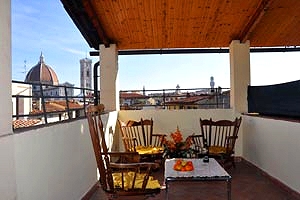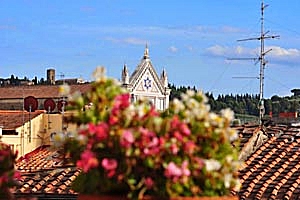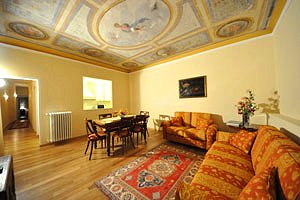The Specola Museum in Florence

Florence - La Specola Museum
Several generations of the Medicis had collected with passion great artistic treasures, but also a wide range of natural treasures like fossils, animals, minerals and exotic plants. This material and the new addition, which includes also a very large collection of books from all over Europe, was used by the enlightened Pietro Leopoldo di Lorena, with the aid of the abbot Felice Fontana (1730-1805) to create a Museum of Natural History opened to the public. For this reason, the prince purchased in 1771 the block of buildings situated next to the Pitti Palace, which still is the present-day location of the museum. "La Specola" was officially inaugurated in 1775; until the early years of the 19th century it -was the only scientific museum specifically created for the public, with opening hours, guides and keepers. Today the philosophy of the museum is very much the same. The history of its collections is rather complex due to the fact that some of the anthropological, botanical and paleonthological pieces originally preserved in the museum have been moved to other museums and university institutes, like many of the instruments used for physics, chemistry and astronomy, which were removed in the years between 1870 and 1930. Today visitors have access to 34 rooms: 24 are dedicated to zoology and 10 to anatomic waxes. The zoological section displays both recently acquired and old examples of animals preserved with the technique of taxidermy, such as the hippopotamus that was apparently given to the Grand Duke in the second half of the 17th century and lived for a few years in the Boboli Gardens. The Museum is particularly proud of its collection of anatomic -waxes, an art introduced in Florence by Ludovico Cigoli (1559-1613), which enjoyed its maximum period of splendour and technical and scientific accuracy during the 18th century. The most famous representative of wax sculpture was Clemente Susini (1754-1814) who made the most important pieces of the collection in the laboratory of the Museum (that has not been in use for over a century). The most important pieces of the wax collection is represented by the group of waxes by Gaetano Zumbo (1656-1701), which possess an extraordinary artistic value besides representing excellent anatomical models. The interior of the museum also houses a very special area: the so-called Tribune of Galileo designed and built in 1841 by the architect Giuseppe Martelli to celebrate the famous Tuscan scientist and to display his instruments together with those belonging to the Accademia del Cimento (this material is now displayed in the Museum of the History of Science). The room is decorated with frescoes and sculptured and inlaid marbles that illustrate some of the most important Italian scientific discoveries from the Renaissance period to our days ..... from `Museums and Galleries of Florence and surroundings` ( Apt - Florence )
La Specola Museum ... More information ..
La Specola Museum
Our most requested apartments in the Florence historical centre:
 Holiday apartments in pretty villa on the southern outskirts of Florence, in the vicinity of Piazzale Michelangelo. Accommodation for groups of 4/6/8/10/12 people. Air conditioning, Internet connection. Just a few minutes from Florence historical centre.
More details
Holiday apartments in pretty villa on the southern outskirts of Florence, in the vicinity of Piazzale Michelangelo. Accommodation for groups of 4/6/8/10/12 people. Air conditioning, Internet connection. Just a few minutes from Florence historical centre.
More details
 Beautiful apartment sleeping 6+2 in Florence historic centre, at a stone`s throw from Santa Maria Novella railway station. Air conditioning, Internet connection and panoramic balcony with view over the Duomo and the Medici Chapels.
More details
Beautiful apartment sleeping 6+2 in Florence historic centre, at a stone`s throw from Santa Maria Novella railway station. Air conditioning, Internet connection and panoramic balcony with view over the Duomo and the Medici Chapels.
More details
 Apartment sleeping 2+1 in the heart of Florence historic centre, in the district of Santa Croce. Panoramic balcony with view over the basilica of Santa Croce, air conditioning, Internet connection, close to the most important Florentine monuments.
More details
Apartment sleeping 2+1 in the heart of Florence historic centre, in the district of Santa Croce. Panoramic balcony with view over the basilica of Santa Croce, air conditioning, Internet connection, close to the most important Florentine monuments.
More details
 Apartment in the historical centre of Florence a few steps away from the Accademia Gallery. Nearby Piazza Duomo, Piazza Signoria, the Uffizi Gallery . 5+2 beds, Internet Connection and air conditioning.
More details
Apartment in the historical centre of Florence a few steps away from the Accademia Gallery. Nearby Piazza Duomo, Piazza Signoria, the Uffizi Gallery . 5+2 beds, Internet Connection and air conditioning.
More details

 Holiday apartments in pretty villa on the southern outskirts of Florence, in the vicinity of Piazzale Michelangelo. Accommodation for groups of 4/6/8/10/12 people. Air conditioning, Internet connection. Just a few minutes from Florence historical centre.
More details
Holiday apartments in pretty villa on the southern outskirts of Florence, in the vicinity of Piazzale Michelangelo. Accommodation for groups of 4/6/8/10/12 people. Air conditioning, Internet connection. Just a few minutes from Florence historical centre.
More details
 Beautiful apartment sleeping 6+2 in Florence historic centre, at a stone`s throw from Santa Maria Novella railway station. Air conditioning, Internet connection and panoramic balcony with view over the Duomo and the Medici Chapels.
More details
Beautiful apartment sleeping 6+2 in Florence historic centre, at a stone`s throw from Santa Maria Novella railway station. Air conditioning, Internet connection and panoramic balcony with view over the Duomo and the Medici Chapels.
More details
 Apartment sleeping 2+1 in the heart of Florence historic centre, in the district of Santa Croce. Panoramic balcony with view over the basilica of Santa Croce, air conditioning, Internet connection, close to the most important Florentine monuments.
More details
Apartment sleeping 2+1 in the heart of Florence historic centre, in the district of Santa Croce. Panoramic balcony with view over the basilica of Santa Croce, air conditioning, Internet connection, close to the most important Florentine monuments.
More details
 Apartment in the historical centre of Florence a few steps away from the Accademia Gallery. Nearby Piazza Duomo, Piazza Signoria, the Uffizi Gallery . 5+2 beds, Internet Connection and air conditioning.
More details
Apartment in the historical centre of Florence a few steps away from the Accademia Gallery. Nearby Piazza Duomo, Piazza Signoria, the Uffizi Gallery . 5+2 beds, Internet Connection and air conditioning.
More details







